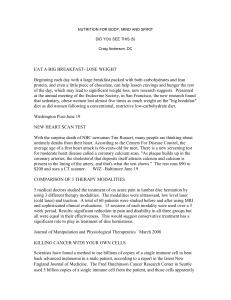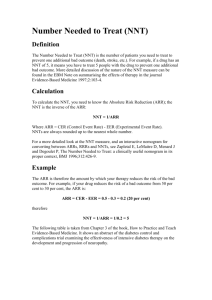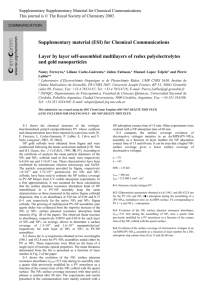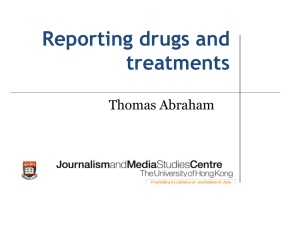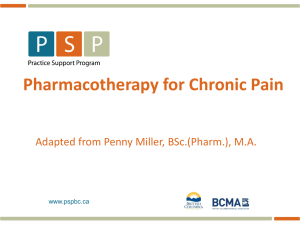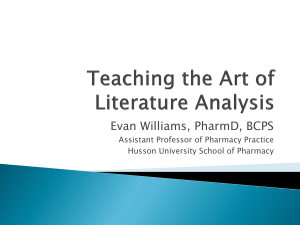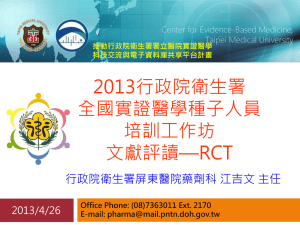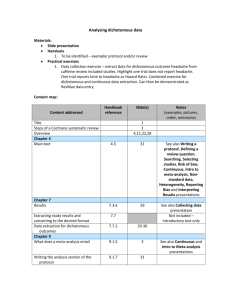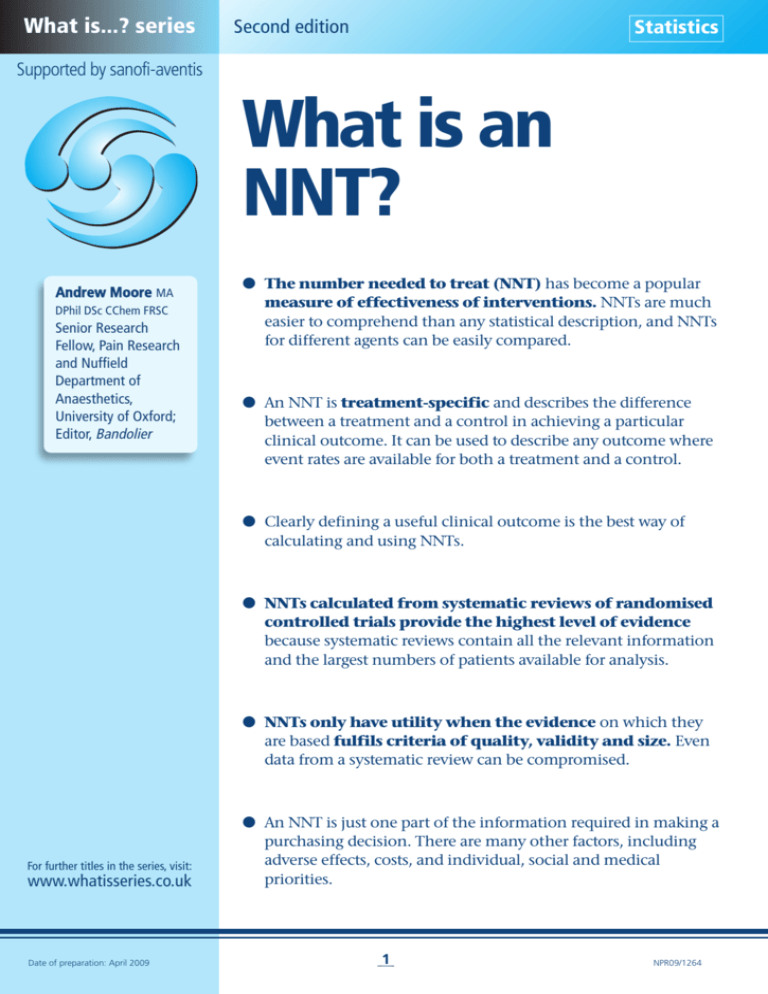
What is...? series
Second edition
Statistics
Supported by sanofi-aventis
What is an
NNT?
Andrew Moore MA
DPhil DSc CChem FRSC
Senior Research
Fellow, Pain Research
and Nuffield
Department of
Anaesthetics,
University of Oxford;
Editor, Bandolier
● The number needed to treat (NNT) has become a popular
measure of effectiveness of interventions. NNTs are much
easier to comprehend than any statistical description, and NNTs
for different agents can be easily compared.
● An NNT is treatment-specific and describes the difference
between a treatment and a control in achieving a particular
clinical outcome. It can be used to describe any outcome where
event rates are available for both a treatment and a control.
● Clearly defining a useful clinical outcome is the best way of
calculating and using NNTs.
● NNTs calculated from systematic reviews of randomised
controlled trials provide the highest level of evidence
because systematic reviews contain all the relevant information
and the largest numbers of patients available for analysis.
● NNTs only have utility when the evidence on which they
are based fulfils criteria of quality, validity and size. Even
data from a systematic review can be compromised.
For further titles in the series, visit:
www.whatisseries.co.uk
Date of preparation: April 2009
● An NNT is just one part of the information required in making a
purchasing decision. There are many other factors, including
adverse effects, costs, and individual, social and medical
priorities.
1
NPR09/1264
What is
an NNT?
What is an NNT?
Rationale for using NNTs
Figure 1. Variation of
relative risk with
control event rate
Why would you want to use something like a
number needed to treat (NNT) and
complicate the nice statistics – such as relative
risks (RRs) and odds ratios (ORs) – we usually
get from clinical trials and meta-analyses? The
trouble is that RRs, for instance, depend much
more on what happens with a control than
with a treatment.
Look at Figure 1. In this hypothetical
example of a series of trials, we use the same
absolute effect – a 30% benefit with treatment
– but vary the event rate for the control group
from 1% to 61%; and, yes, control event rates
this high do occur in some circumstances,
and occur frequently in small trials, because
of the random play of chance. You can see
that the RR varies massively, from over 30 to
just over 1.5; however, the same absolute
benefit is given, with an extra 30% of patients
benefiting in each case, and in each case the
NNT is 3.3.
Now look at Table 1, which shows how the
NNT varies with the absolute risk increase
(the percentage of patients benefiting because
of the treatment). In each of these trials, the
RR is the same, yet the proportion of patients
benefiting from treatment varies from 1%
to 44%.
Relative risk or benefit
100–
10–
1–
1
11
Date of preparation: April 2009
21
31
41
Control event rate (%)
51
61
2
Of course we need statistical outcomes to
tell us whether a result is statistically
significant, using well-tried, formal tests of
significance; however, we need to go further
than this because the statistical result is not
helpful in making clinical practice decisions.
Here the NNT (or NNT to prevent [NNTp],
or number needed to harm [NNH] – see
below) can help to identify the
proportion of patients likely to have
treatment-specific effects.
The best NNT is 1, when everyone
experiences benefit with the treatment and
no one with the control. The worst NNT is
–1, when everyone experiences benefit with
the control and no one with the treatment.
Between these two extremes, NNT values
increase to infinity, when there is no
difference between treatment and control.
NNTs as a measure of effectiveness
Treatment specificity
An NNT is treatment-specific. It describes the
difference between active treatment and
control in achieving a particular clinical
outcome.
An NNT of 1 means that a favourable
outcome occurs in every patient given
the treatment and in no patient in a
comparison group – the ‘perfect’ result in,
say, a therapeutic trial comparing an
antibiotic with a placebo, such as in the
eradication of Helicobacter pylori infection
(Table 2).1,2
Studies of treatments usually involve big
effects in (relatively) small numbers of
patients and, therefore, may have ‘better’
NNTs than those of prophylactic
interventions. There are no set limits for
NNTs to be considered clinically effective, but
it is generally considered that the lower the
NNT (the closer to 1), the better.
A correctly defined NNT must always
specify the comparator, the therapeutic
outcome, the duration of treatment necessary
to achieve that outcome and the 95%
confidence interval (CI).
NPR09/1264
What is
an NNT?
Table 1. Six hypothetical trials showing variation of NNT with absolute event rates*
Trial
Number of patients
with outcome
EER
(%)
CER
(%)
RR
AR increase
(%)
NNT
Active
Placebo
1
800
360
80
36
2.2
44
2.3
2
400
180
40
18
2.2
22
4.6
3
200
90
20
9
2.2
11
9.1
4
100
45
10
5
2.2
5
18.2
5
50
23
5
2
2.2
3
37.0
6
20
9
2
1
2.2
1
90.9
* Trials with 1,000 patients each given active treatment or placebo
AR: absolute risk; CER: control event rate; EER: experimental event rate; NNT: number needed to treat; RR: relative risk
Calculating an NNT
The NNT can be calculated from the simple
formula:
1
NNT =
(proportion benefiting from experimental intervention)
– (proportion benefiting from a control intervention)
A fuller mathematical description is given
in Box 1.
For prophylaxis, where fewer events
occur in the treated group, the calculation
shown will produce negative NNTs. You
can use those numbers by simply ignoring
the sign (the numbers will still be correct), or
you can switch the active and control groups
around to provide NNTs with a positive sign.
NNTs can also be calculated from statistical
outputs of clinical trials or systematic reviews,
from ORs and from the relative risk reduction
(RRR) – see the ‘Further reading’ section
below for more information on these
statistical measures.
There is no absolute value for an NNT that
defines whether something is effective or not.
NNTs for treatments are usually low because
we expect large effects in small numbers of
people. Since few treatments are 100%
effective and few controls – even placebo or
no treatment – are without some effect, NNTs
for very effective treatments are usually in the
range of 2 to 4. An exception to this might be
the use of antibiotics. The NNT for H pylori
eradication with triple or dual therapy, for
instance, is 1.1. NNTs may also be calculated
for different outcomes; so, to use the same
example, the NNT for preventing one ulcer
recurrence at one year is 1.8 (Table 2).1,2
Larger NNTs can be found with useful
interventions – for instance prophylactic
measures – where few patients are affected in
large populations. Aspirin, which prevents
one death at five weeks after a myocardial
infarction, has an NNT of 40 but is regarded
as beneficial. The same is true for instituting
thrombolytic therapy as early as possible
Box 1. The key formula
Calculating a number needed to treat (NNT)
NNT =
1
(IMPact/TOTact) – (IMPcon/TOTcon)
where:
IMPact = number of patients given active treatment achieving the target
TOTact = total number of patients given the active treatment
IMPcon = number of patients given a control treatment achieving the target
TOTcon = total number of patients given the control treatment
Date of preparation: April 2009
3
NPR09/1264
What is
an NNT?
Table 2. Examples of NNTs calculated from systematic reviews1,2
Treatment
Comparator
Duration of
intervention
Outcome
NNT (CI)
Peptic ulcer
Triple therapy
Histamine
antagonist
6–10 weeks
Helicobacter pylori
eradication
1.1 (1.08–1.15)
Peptic ulcer
Triple therapy
Histamine
antagonist
6–10 weeks
Ulcers remaining
cured at 1 year
1.8 (1.6–2.1)
Migraine
Oral
sumatriptan
Placebo
Single dose
Headache relieved
at 2 hours
2.6 (2.3–3.2)
Postoperative
pain
Paracetamol
Placebo
1,000 mg
single dose
At least 50% pain
relief
3.6 (3.0 to 4.4)
Fungal nail
infection
Terbinafine
Griseofulvin
12 or 24 weeks
Cured at
48 weeks
2.7 (1.9–4.5)
Painful diabetic
neuropathy
Antidepressant
Placebo
At least 50%
pain relief
2.9 (2.4–4.0)
Postoperative
vomiting
Droperidol
Placebo
Single dose
Prevention for
48 hours in
children
undergoing squint
correction
4.4 (3.1–7.1)
Peptic ulcer
Triple therapy
Histamine
antagonist
6–10 weeks
Ulcers healed at
6–10 weeks
4.9 (4.0–6.4)
Venous
thromboembolism
Graduated
compression
stockings
No stockings
Episodes of venous
thromboembolism
9 (7–13)
Anticipated
preterm delivery
Corticosteroids
No treatment
Before delivery
Risk of foetal RDS
11 (8–16)
Dog bites
Antibiotics
Placebo
Single course
Infection
16 (9–92)
Hypertension in
the elderly
Drug
treatments
No treatment
At least 1 year
Overall prevention
of cardiovascular
event over 5 years
18 (14–25)
Myocardial
infarction
Aspirin alone
No treatment
Myocardial
infarction
Thrombolytic
Later treatment
therapy 5 hours
earlier
Prevention of one
40
5-week vascular death
Prevention of one
100
5-week vascular death
CI: confidence interval; NNT: number needed to treat; RDS: respiratory distress syndrome
(beginning thrombolytic therapy five hours
earlier has an NNT of 100).2
The ‘NNT method’ is now also being used
in other ways. For example, it can be used to
examine adverse effects of treatments or
interventions, when it becomes the NNH.
There are few examples, but, for instance, the
use of epidural analgesia during childbirth is
reported to produce higher rates of caesarean
Date of preparation: April 2009
4
section. If that were regarded as harm, then
the NNH would be 10.1
Examples of NNT calculations
‘The NNT is the reciprocal of the change
in absolute risk brought about by an
intervention.’
What does this mean? A few examples will
serve to show how it works. As always, it is
NPR09/1264
What is
an NNT?
easier to look at some real examples rather
than at meaningless hypothetical
calculations, and what follows is a series of
examples taken from relatively recent
systematic reviews or clinical trials. These are
expanded in Table 2 with a series of other
examples from the literature.
epileptic drugs. A Cochrane review reported
on randomised, mainly double-blind, trials
usually lasting several months.4 One outcome
was the number of patients having at least a
50% reduction in the number of migraine
attacks over 28 days, reported in five trials for
various forms of valproate.
Example 1. Paracetamol in
acute postoperative pain
The review of these trials showed the
following results.
● With valproate, 174/383 (45%) patients had
the number of migraine attacks reduced by
at least half.
● With placebo, 54/259 (21%) had the same
outcome.
If you were responsible for organising pain
relief after day-case or minor surgery, you
would want to make sure that patients had
good pain relief. Your first choice of analgesic
might well be paracetamol, but then you’d
ask yourself – just how good is it as an
analgesic in this circumstance? Fortunately, a
Cochrane review provides lots of data to help
you make your decision.3
In 28 randomised trials with 3,200
patients, the results were as follows.
● With paracetamol 975 or 1,000 mg,
876/1,903 (46%) patients with moderate or
severe postoperative pain had the outcome
of at least 50% pain relief over six hours.
● With placebo, 241/1,329 (18%) patients
had the same outcome.
The NNT was, therefore:
1/(876/1,903) – (241/1,329)
= 1/(0.46 – 0.18)
= 1/0.28
= 3.6
For every four patients with moderate or
severe postoperative pain, one would have at
least 50% pain relief who would not have that
relief with placebo. Taking into account that
half of those given paracetamol 1,000 mg
needed more analgesic within six hours and
that, on average, the time to remedication was
less than four hours, you might wonder
whether there were any alternatives.
Fortunately, Cochrane offers lots of evidence
on this point (www.cochrane.org/reviews/
clibintro.htm).
Example 2. Anti-epileptics in
the management of frequent
migraine attacks
When people have frequent migraine attacks,
a number of measures can be tried to reduce
the rate. One measure is the use of anti-
Date of preparation: April 2009
5
The NNT was, therefore:
1/(174/383) – (54/259)
= 1/(0.45 – 0.21)
= 1/0.24
= 4.1
So, for every four people with frequent
migraine attacks (typically more than two
attacks per month), one would have the
frequency reduced by half with valproate who
would not have achieved this response with
placebo.
Example 3. Clopidogrel plus
aspirin to prevent vascular events,
compared with antiplatelet
monotherapy
In certain circumstances, when patients are at
a high risk of adverse vascular events, the
question is asked whether using two
antiplatelet interventions is better than using
only one. A systematic review analysed
randomised trials comparing clopidogrel plus
aspirin with antiplatelet monotherapy.5 The
outcome was any major vascular event,
including death, stroke or myocardial
infarction. Patients included those with acute
coronary syndrome, those undergoing
percutaneous coronary intervention and
others.
A review of eight randomised trials with
over 91,000 patients showed the following
results.
● With clopidogrel plus aspirin,
4,883/45,930 (11%) patients had the
outcome of death, stroke, or myocardial
infarction.
NPR09/1264
What is
an NNT?
● With monotherapy, 5,790/45,974 (13%)
had the same outcome.
The NNT was, therefore:
1/(4,883/45,930) – (5,790/45,974)
= 1/(0.11 – 0.13)
= 1/0.02
= –51
The negative sign here shows that for every
50 people treated with clopidrogel and aspirin
rather than antiplatelet monotherapy, one
fewer will suffer a major vascular event.
Here the NNT can be given as an NNTp, in
which case the sign would alter, and the
NNTp would be 51.
Example 4. Statins for people with
low cholesterol but elevated Creactive protein
Media reports suggest that using statins in
low-risk men is effective, reducing the risk of
heart attack by half. The implication (by the
media) is that everyone should be on statins.
For further details, please refer to the paper
directly.6
To be eligible for the study, men had to be
at least 50 and women at least 60 years of age.
Their LDL-cholesterol levels had to be below
3.4 mmol/l, triglyceride levels had to be below
5.6 mmol/l and C-reactive protein levels had
to be 2 mg/l or greater. Although about
18,000 people participated, 90,000 were
screened for eligibility. The trial’s primary
outcome was a complex one of heart attack,
stroke, admission for unstable angina,
revascularisation and death from
cardiovascular cause after five years of
treatment with rosuvastatin 20 mg or placebo.
For the trial’s primary outcome, the results
were as follows.
● With rosuvastatin 20 mg, 142/8,901 (1.6%)
participants had the primary outcome.
● With placebo, 251/8,901 (2.8%) had the
same outcome.
The NNT was, therefore:
1/(142/8,901) – (251/8,901)
= 1/(0.016 – 0.028)
= 1/–0.012
= –81
Date of preparation: April 2009
6
For the combined endpoint of myocardial
infarction, stroke, or death from
cardiovascular causes, the results were as
follows.
● With rosuvastatin 20 mg, 83/8,901 (0.9%)
participants had the combined outcome of
myocardial infarction, stroke, or death
from cardiovascular causes.
● With placebo, 157/8,901 (1.8%) had the
same outcome.
The NNT was, therefore:
1/(83/8,901) – (157/8,901)
= 1/(0.009 – 0.018)
= 1/–0.009
= –120
Again, the negative sign here shows that
we are dealing with an NNTp. To prevent one
case of myocardial infarction, stroke, or death
from cardiovascular causes, we have to treat
120 people with rosuvastatin 20 mg daily for
five years.
Example 5. Perioperative betablockers in non-cardiac surgery
Should perioperative beta-blockers be used in
non-cardiac surgery, or do they cause harm?
A useful meta-analysis provides the figures,
showing some benefits and some harm.7 Our
main interest is whether there is a problem
with perioperative bradycardia requiring
treatment, or with perioperative
hypotension.
For perioperative bradycardia, the
meta-analysis showed the following
results.
● With beta-blockers, 308/1,889 (16%)
participants had perioperative bradycardia
requiring treatment.
● With the control, 120/1,615 (7.4%) had the
same outcome.
The NNT was, therefore:
1/(308/1,889) – (120/1,615)
= 1/(0.16 – 0.074)
= 1/0.086
= 12
For perioperative hypotension, the metaanalysis showed the following results.
● With beta-blockers, 460/1,858 (25%)
NPR09/1264
What is
an NNT?
participants had perioperative
hypotension.
● With the control, 280/1,563 (18%) had the
same outcome.
The NNT was, therefore:
1/(460/1,858) – (280/1,563)
= 1/(0.25 – 0.18)
= 1/0.07
= 14
Here the NNT becomes the NNH. For every
12 or 14 people treated with beta-blockers
perioperatively, there will be one more case of
bradycardia and one more case of
hypotension.
Implications of NNTs
NNTs are useful in making policy decisions
and decisions regarding individual patients.
There are some important points to
remember, though.
● NNTs can be calculated from any trial
data that present dichotomous
information. As in our examples above,
information is needed on how many
patients achieve a particular treatment
benefit, such as pain relief to a certain
level, or not dying. So, some thought has
to be given to defining a worthwhile
outcome.
● When NNTs are calculated, the
circumstances are all important. These
include the comparison being made (with
placebo, or another active treatment), the
dose of a drug and/or duration of
treatment, and the outcome.
● Any NNT is just a point estimate. All
point estimates have some uncertainty
around them, usually reflected in the 95%
CI. For example, an NNT of 5.0 (3.6–7.2)
means that 19 times out of 20 the result
would fall in the range of 3.6 to 7.2 if the
studies were repeated. The CI becomes
narrower as the amount of data increases,
so large trials give a smaller interval than
small trials. NNTs calculated from
systematic reviews of randomised
controlled trials provide the highest level
of evidence.
Date of preparation: April 2009
7
● NNTs can be used to calculate
different endpoints from the same
studies. Thus the H pylori example in
Table 2 has three separate endpoints – H
pylori eradication, ulcer healing at six
weeks after treatment and ulcers still cured
one year later.
● Comparison across treatments may be
sensible, but only when comparisons are
on a like-for-like basis. So, comparing
NNTs from, say, lipid-lowering in one
study with a six-month outcome against
another study with a three-year outcome
would present some difficulty.
● NNTs can be used to express other
features, such as harm. Adverse effects
of treatment will increasingly be examined
in this way and we will begin to see the
NNH as well as the NNT.
● NNT is only one part of any assessment
about purchase of treatment. There are
many other factors, including adverse
effects, costs, social and medical priorities.
● When clinicians and policy makers were
presented with research results in different
formats – NNTs, absolute risk reductions
(ARRs) and RRRs – they made more
conservative decisions when they received
treatment effects expressed as NNTs than
when they received them as RRRs or ARRs.
References
1. McQuay HJ, Moore RA. Using numerical results from
systematic reviews in clinical practice. Ann Intern Med
1997; 126: 712–720.
2. Farkouh ME, Lang JD, Sackett DL. Thrombolytic
agents: the science of the art of choosing the better
treatment. Ann Intern Med 1994; 120: 886–888.
3. Toms L, McQuay HJ, Derry S, Moore RA. Single dose
oral paracetamol (acetaminophen) for postoperative pain
in adults. Cochrane Database Syst Rev 2008: CD004602.
4. Chronicle E, Mulleners W. Anticonvulsant drugs for
migraine prophylaxis. Cochrane Database Syst Rev 2004:
CD003226.
5. Bowry AD, Brookhart MA, Choudhry NK. Metaanalysis of the efficacy and safety of clopidogrel plus
aspirin as compared to antiplatelet monotherapy for the
prevention of vascular events. Am J Cardiol 2008; 101:
960–966.
6. Ridker PM, Danielson E, Fonseca FA et al. Rosuvastatin
to prevent vascular events in men and women with
elevated C-reactive protein. N Engl J Med 2008; 359:
2195–2207.
7. Bangalore S, Wetterslev J, Pranesh S et al. Perioperative
beta blockers in patients having non-cardiac surgery: a
meta-analysis. Lancet 2008; 372: 1962–1976.
Further reading
Moore RA, McQuay HJ. Bandolier’s Little Book of Making
Sense of the Medical Evidence. Oxford: Oxford University
Press, 2006.
NPR09/1264
What is...? series
What is
an NNT?
First edition published 2001.
Authors: Andrew Moore and
Henry J McQuay
This publication, along with
the others in the series, is
available on the internet at
www.whatisseries.co.uk
The data, opinions and statements
appearing in the article(s) herein
are those of the contributor(s)
concerned. Accordingly, the
sponsor and publisher, and their
respective employees, officers
and agents, accept no liability
for the consequences of any such
inaccurate or misleading data,
opinion or statement.
Published by Hayward Medical
Communications, a division of
Hayward Group Ltd.
Copyright © 2009 Hayward
Group Ltd.
All rights reserved.
Supported by sanofi-aventis
Date of preparation: April 2009
8
NPR09/1264

